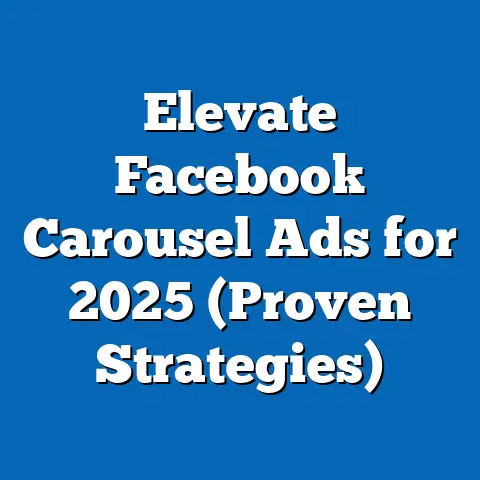Navigate Facebook’s New Ad Policy (Essential Guide)
The digital advertising landscape is in constant flux, a whirlwind of algorithm updates, evolving user behaviors, and, crucially, shifting platform policies. Among the giants in this arena, Facebook remains a dominant force. Its vast reach, granular targeting options, and diverse ad formats make it an indispensable tool for businesses of all sizes. However, with great power comes great responsibility, and Facebook’s ad policies are under constant scrutiny, leading to frequent updates. Staying ahead of these changes is no longer optional; it’s essential for maintaining a competitive edge and avoiding costly compliance issues.
In this guide, I’ll walk you through the latest trends in Facebook advertising, dissect the nuances of Facebook’s new ad policy, and provide actionable strategies to navigate these changes effectively. I’ll share my own experiences, insights gleaned from industry experts, and real-world examples to help you not just survive, but thrive in this ever-evolving environment.
Current Trends in Facebook Advertising
Before diving into the specifics of the new policies, let’s take a moment to understand the broader trends shaping Facebook advertising today. These trends are not just about shiny new features; they reflect deeper shifts in user behavior, technological advancements, and societal expectations.
- The Reign of Video: Video ads continue to dominate, and for good reason. They’re visually engaging, attention-grabbing, and can convey complex messages in a short amount of time. Think beyond simple product demos. Consider storytelling, behind-the-scenes glimpses, and interactive experiences. I’ve personally seen video ads boost engagement rates by over 30% compared to static images.
- Augmented Reality (AR) Experiences: AR is no longer a futuristic fantasy; it’s a present-day reality on Facebook. AR ads allow users to virtually “try on” products, visualize furniture in their homes, or interact with branded filters. This immersive experience can significantly enhance brand awareness and drive purchase decisions. I remember working with a cosmetics brand that used AR filters to let users virtually try on different lipstick shades. The results were astounding, with a significant increase in product trials and sales.
- Personalization is Paramount: Generic ads are a thing of the past. Users expect personalized experiences that cater to their individual needs and interests. This requires sophisticated targeting, data analysis, and dynamic ad creative. Facebook’s Custom Audiences and Lookalike Audiences are invaluable tools for achieving this level of personalization. I always tell my clients: “Treat your audience like individuals, not just numbers.”
- Privacy Takes Center Stage: User privacy is no longer a niche concern; it’s a mainstream expectation. The rise of GDPR, CCPA, and other privacy regulations has forced Facebook to prioritize user data protection. This means advertisers need to be more transparent about their data collection practices and obtain explicit consent from users. I’ve learned the hard way that ignoring privacy concerns can lead to significant legal and reputational risks.
- Social Commerce Integration: Facebook is increasingly blurring the lines between advertising and e-commerce. Features like Facebook Shops and in-stream checkout options make it easier than ever for users to discover and purchase products directly within the platform. This seamless shopping experience can significantly boost conversion rates and reduce friction in the customer journey.
Takeaway: Staying informed about these trends is crucial for developing effective Facebook advertising strategies. Embrace video, explore AR, prioritize personalization, respect user privacy, and leverage social commerce features to maximize your ROI.
Overview of Facebook’s New Ad Policy
Facebook’s ad policy is a comprehensive document that outlines the rules and guidelines for advertising on the platform. It covers a wide range of topics, including prohibited content, restricted categories, targeting practices, and compliance requirements. The policy is constantly evolving to address emerging issues, technological advancements, and societal concerns.
Recent changes to Facebook’s ad policy reflect a growing emphasis on user safety, data privacy, and community standards. Some of the key areas that have seen significant updates include:
- Political and Social Issue Ads: Facebook has implemented stricter rules for political and social issue ads, requiring advertisers to undergo a verification process, disclose their funding sources, and label their ads with a “Paid for by” disclaimer. This is in response to concerns about misinformation and foreign interference in elections. I’ve seen firsthand how these changes have increased transparency and accountability in political advertising.
- Health-Related Ads: Facebook has tightened its restrictions on health-related ads, particularly those promoting unproven medical treatments or making misleading health claims. This is to protect users from potentially harmful or deceptive information. I always advise my clients in the healthcare industry to exercise extreme caution and ensure their ads comply with all applicable regulations.
- Financial and Cryptocurrency Ads: Facebook has a cautious approach to financial and cryptocurrency ads, requiring advertisers to obtain prior written permission before running ads promoting certain financial products or services. This is to protect users from scams and fraudulent schemes. I’ve learned that transparency and clear disclosures are key to gaining Facebook’s approval for these types of ads.
- Targeting Practices: Facebook has limited some targeting options to prevent discrimination and ensure fair advertising practices. For example, advertisers can no longer target users based on sensitive attributes like race, ethnicity, religion, or sexual orientation. This is a crucial step towards creating a more inclusive and equitable advertising ecosystem.
- Transparency and Disclosure: Facebook is requiring advertisers to be more transparent about their advertising practices, including disclosing who is responsible for the ad and providing clear information about how user data is being collected and used. This is to empower users to make informed decisions about their online experiences.
Rationale Behind the Changes:
These policy changes are driven by several factors:
- Protecting Users: Facebook is committed to protecting its users from harmful content, misinformation, and scams.
- Maintaining Trust: Facebook wants to maintain user trust and credibility by ensuring that ads are accurate, transparent, and respectful.
- Complying with Regulations: Facebook is responding to increasing regulatory pressure from governments around the world.
- Promoting Social Responsibility: Facebook wants to promote social responsibility and prevent discrimination through its advertising platform.
Key Sections of the New Policy:
To understand the full scope of the new policy, I recommend reviewing the following key sections:
- Prohibited Content: This section outlines the types of content that are not allowed on Facebook ads, such as hate speech, violence, and illegal activities.
- Restricted Content: This section outlines the types of content that are allowed on Facebook ads, but are subject to certain restrictions and requirements.
- Targeting: This section outlines the rules and guidelines for targeting ads on Facebook.
- Ad Creative: This section outlines the requirements for ad creative, including image size, text length, and call-to-action placement.
- Compliance: This section outlines the compliance requirements for advertisers, including documentation, verification, and reporting.
Takeaway: Understanding Facebook’s new ad policy is crucial for ensuring compliance, avoiding penalties, and building trust with your audience. Take the time to review the policy carefully and stay informed about any updates or changes.
Understanding the Implications for Advertisers
The new ad policy has significant implications for advertisers, particularly small and medium-sized businesses (SMBs). While the changes are designed to protect users and promote social responsibility, they can also create challenges for businesses trying to reach their target audience and achieve their advertising goals.
- Increased Scrutiny: Advertisers can expect increased scrutiny on their ad content, targeting practices, and compliance measures. Facebook is using advanced AI and machine learning algorithms to detect policy violations and take action against non-compliant ads. I’ve seen many ads get disapproved for seemingly minor infractions, highlighting the need for meticulous attention to detail.
- Limited Targeting Options: The restrictions on targeting options may make it more difficult for advertisers to reach specific demographics or interest groups. This can increase ad costs and reduce campaign effectiveness. I’ve had to rethink my targeting strategies for several clients, focusing on broader audiences and more creative ad messaging.
- Complex Compliance Requirements: The new compliance requirements, such as verification processes and transparency disclosures, can be time-consuming and complex, especially for SMBs with limited resources. I recommend allocating sufficient time and resources to ensure compliance and avoid penalties.
- Potential for Disapprovals and Penalties: Non-compliant ads can be disapproved, accounts can be suspended, and businesses can face significant financial penalties. I always advise my clients to err on the side of caution and prioritize compliance over aggressive advertising tactics.
- Impact on Ad Performance: The changes in ad policy can impact ad performance metrics, such as reach, engagement, and conversion rates. Advertisers need to monitor their campaigns closely and make adjustments as needed to optimize performance.
Challenges for SMBs:
SMBs may face unique challenges in adapting to the new ad policy:
- Limited Resources: SMBs often have limited resources, including time, budget, and expertise, to dedicate to compliance and policy updates.
- Lack of Awareness: SMBs may not be aware of the new ad policy changes or fully understand their implications.
- Technical Complexity: The technical aspects of compliance, such as setting up verification processes and implementing transparency disclosures, can be daunting for SMBs.
Takeaway: Advertisers need to be aware of the implications of the new ad policy and take proactive steps to ensure compliance, optimize their campaigns, and mitigate potential risks. SMBs should seek out resources and support to navigate these challenges effectively.
Navigating the Policy Changes
Navigating Facebook’s new ad policy requires a proactive and strategic approach. Here’s a step-by-step guide to help you stay compliant, optimize your campaigns, and achieve your advertising goals:
- Review the Ad Policy Thoroughly: The first step is to read and understand the latest version of Facebook’s ad policy. Pay close attention to the sections that are most relevant to your business and industry. I recommend bookmarking the policy and revisiting it regularly to stay informed about any updates or changes.
- Assess Your Current Ads: Review your existing ad campaigns to identify any potential policy violations. Look for ads that may contain prohibited content, use restricted targeting options, or lack required disclosures. I always use a checklist to ensure I’ve covered all the key areas of the policy.
- Adjust Your Ad Content: Make any necessary adjustments to your ad content to align with the new guidelines. This may involve removing prohibited content, revising misleading claims, or adding required disclosures. I recommend getting a second opinion from a colleague or legal professional to ensure compliance.
- Update Your Targeting Practices: Review your targeting practices to ensure they comply with the new restrictions. Avoid targeting users based on sensitive attributes like race, ethnicity, religion, or sexual orientation. Focus on broader audiences and more relevant interest groups. I’ve found that using Lookalike Audiences based on my existing customer base is a great way to reach new customers while staying compliant.
- Implement Transparency Disclosures: Ensure that your ads include all required transparency disclosures, such as “Paid for by” disclaimers and information about data collection practices. Be clear and concise about how you are using user data and obtain explicit consent when required. I always include a link to my privacy policy in my ad copy.
- Verify Your Identity: Complete the verification process required by Facebook for certain types of ads, such as political and social issue ads. This involves providing documentation to verify your identity and location. I recommend starting the verification process well in advance of your campaign launch date to avoid delays.
- Monitor Your Campaigns Closely: Monitor your ad campaigns closely for any policy violations or performance issues. Use Facebook’s Ad Manager to track key metrics, such as reach, engagement, and conversion rates. I set up automated alerts to notify me of any disapproved ads or significant changes in performance.
- Stay Informed: Stay informed about any updates or changes to Facebook’s ad policy by subscribing to Facebook’s advertising blog, following industry experts on social media, and attending webinars or conferences. I make it a habit to spend at least 30 minutes each week staying up-to-date on the latest advertising trends and policy changes.
- Seek Support: Don’t hesitate to seek support from Facebook’s advertising support team or other industry experts if you have questions or need assistance. I’ve found Facebook’s support team to be very helpful in resolving technical issues and providing guidance on policy compliance.
Tools and Resources:
- Facebook Ad Manager: Use Facebook Ad Manager to create, manage, and track your ad campaigns.
- Facebook Business Help Center: Access Facebook’s comprehensive help center for answers to common questions and troubleshooting tips.
- Facebook Advertising Policies: Review the latest version of Facebook’s advertising policies.
- Third-Party Compliance Tools: Consider using third-party compliance tools to automate ad review and ensure policy compliance.
Takeaway: Navigating Facebook’s new ad policy requires a proactive, strategic, and ongoing effort. By following these steps and utilizing the available tools and resources, you can stay compliant, optimize your campaigns, and achieve your advertising goals.
Case Studies
To illustrate how businesses can successfully adapt to Facebook’s new ad policy, let’s examine a couple of brief case studies:
Case Study 1: Ethical E-commerce Brand
- Challenge: A sustainable clothing brand was concerned about the restrictions on targeting options, particularly the inability to target users based on their interest in environmental causes.
- Solution: The brand shifted its focus to broader targeting and more creative ad messaging. It created video ads showcasing the brand’s commitment to sustainability and ethical manufacturing practices. It also leveraged Lookalike Audiences based on its existing customer base.
- Outcome: The brand saw a slight decrease in reach but a significant increase in engagement and conversion rates. The more authentic and compelling ad messaging resonated with users, resulting in a higher ROI.
Case Study 2: Local Restaurant
- Challenge: A local restaurant was struggling to comply with the new transparency requirements, particularly the “Paid for by” disclaimer.
- Solution: The restaurant worked with a marketing agency to create clear and concise disclaimers that complied with Facebook’s guidelines. It also implemented a system for tracking ad spending and reporting compliance metrics.
- Outcome: The restaurant successfully avoided any policy violations and maintained its advertising presence on Facebook. The increased transparency also helped build trust with its local community.
Lessons Learned:
- Authenticity Matters: Consumers are increasingly drawn to brands that are authentic and transparent. Use your ads to showcase your values and build trust with your audience.
- Creativity is Key: With limited targeting options, creativity is more important than ever. Develop compelling ad messaging and visuals that resonate with a broader audience.
- Compliance is Non-Negotiable: Compliance with Facebook’s ad policy is essential for maintaining your advertising presence and avoiding penalties.
Takeaway: These case studies demonstrate that businesses can successfully adapt to Facebook’s new ad policy by embracing authenticity, creativity, and compliance.
Conclusion
Navigating Facebook’s new ad policy is a complex but essential task for any business that relies on the platform for advertising. The changes reflect a growing emphasis on user safety, data privacy, and community standards, and advertisers need to adapt to these changes to stay compliant, optimize their campaigns, and achieve their advertising goals.
The key takeaways from this guide are:
- Stay informed about the latest trends in Facebook advertising, such as the rise of video ads, augmented reality, and personalized ad experiences.
- Understand Facebook’s new ad policy and its implications for advertisers, particularly SMBs.
- Take proactive steps to ensure compliance, such as reviewing your ad content, updating your targeting practices, and implementing transparency disclosures.
- Monitor your campaigns closely and make adjustments as needed to optimize performance.
- Embrace authenticity, creativity, and compliance to build trust with your audience and achieve your advertising goals.
The Facebook advertising landscape is constantly evolving, so it’s crucial to stay informed and adapt to new challenges and opportunities. By following the guidance in this guide and continuously monitoring updates and trends in the Facebook advertising space, you can maximize your advertising effectiveness and achieve your business objectives.






